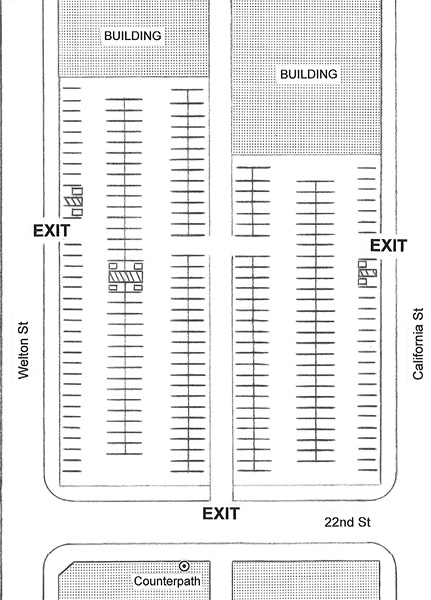
PARKING LOT LINES
first performed on April 14, 2014
A parking lot across the street from Counterpath Press, Denver, CO
performed once in 2014
LARKIN HIGGINS
Los Angeles, CA
535966713w535966713o535966713r535966713d535966713i535966713m535966713a535966713g535966713e5359667132535966713@535966713g535966713m535966713a535966713i535966713l535966713.535966713c535966713o535966713m
counterpathpress.blogspot.com/2014/05/larking-higginss-parking-lot-lines.html
PARKING LOT LINES
LARKIN HIGGINS
The original instructions for “Parking Lot Lines” were hand-lettered onto architecture title block vellum and a paper blueprint was created—a “plan” for space and language. This blueprint, outlining the durational performance, was exhibited as a “wall artwork” first (1994), but never performed. Twenty years later the blueprint was displayed in my exhibit at Counterpath Press. A parking lot located directly across the street—and an invitation to fully engage the performance:
-
Select a parking lot, preferably one fully occupied at least part of the day.
-
Select a written story, original or previously published.
-
Photocopy the story as many times as there are spaces in the parking lot.
-
On the first photocopy, draw a line through all the sentences except the first one. On the second photocopy, line through all but the second sentence. Continue this sequential process until the last line. If more “unlined” photocopies remain, repeat until every sheet of paper is “lined.”
-
Place one “lined” photocopy on each car windshield in the parking lot.
-
During a 24 hour period (or other time frame of choice), collect these photocopies in the same sequence as cars depart from the lot.
-
Record each “unlined” sentence in chronological order to form a revised story.
A dilemma—the parking lot had three exits. A Denver writer, Eric Siegel, volunteered to oversee one. After “essay-flyers” were placed on car windshields, smartphone stopwatches were synchronized. With pen in hand, we waited to gather story pages, then wrote down each receiving time in minutes/seconds. I managed two exits, running/walking back and forth between them. Collection duration time: 4-6:30 pm on a Monday. The purpose was not to assault people after their nine to five work day, tired and ready to go home. “PLEASE …This is an artwork you are helping to complete” was handwritten on top. As an observer, this became a sociological study with respect for entering people’s private time in a public space, which then merged into a temporary social space. Coincidentally, the re-ordered text began, “The public gathers in two kinds of spaces.”